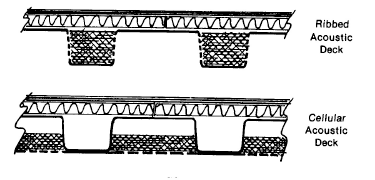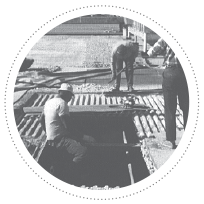 A roof deck must be visually inspected before loading any materials or equipment and before the roofing application can commence. Document and report all deficiencies to the job superintendent. Do not proceed with a roofing installation until all deficiencies have been corrected. A roof system installed on a sub-standard deck could cause the roofing contractor to assume responsibilities that they may have been able to avoid had a proper deck inspection been completed.
A roof deck must be visually inspected before loading any materials or equipment and before the roofing application can commence. Document and report all deficiencies to the job superintendent. Do not proceed with a roofing installation until all deficiencies have been corrected. A roof system installed on a sub-standard deck could cause the roofing contractor to assume responsibilities that they may have been able to avoid had a proper deck inspection been completed.
On new construction, the drawings should be consulted to ensure all deck details have been correctly installed.
During reroofing, the foreman or superintendent should check the existing deck to ensure no deficiencies exist before beginning the application of the new roofing system. Any problems with the deck should be corrected before the roof application is allowed to start.
Although some steps in the procedure for inspecting the deck apply to all three types of decks (wood, steel and concrete), there are some steps unique to each type of deck. This section will first discuss the procedures applicable to all three types of decks and then discuss the steps unique to each type of deck separately.
3.1.3.1 Inspection of All Deck Types (Wood, Steel and Concrete)
There are 6 major steps for inspecting all types of decks (wood, steel, and concrete).
- Roof Structure
The roof structure must possess the capacity to support the anticipated weight of the roof system being installed and live loads (snow, rain, etc.). The proper design and support of a roof deck is the responsibility of a professional structural engineer. However, by inspecting the roof you may spot areas of weakness which you should bring to the immediate attention of the project superintendent.
Areas of weakness can result in serious deflection, unusual bounciness and movement in the deck, corrosion of steel deck surfaces or rotted wood planks. - Deck Surface
Note whether the deck surface is uninterrupted, clean, and dry. Before a roofing system can be installed, the deck surface must be continuous, free from all dirt and debris and thoroughly dry. - Deck Slope
Determine the deck slope and direction. The recommended slope for a conventional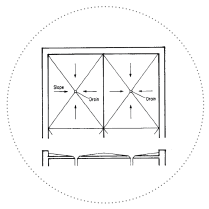 built-up roof is 1:50 (2%). When installing a protected membrane roof system, the deck must have a minimum positive slope of 1:50 (2%). Loose laid and ballasted roofs can only be installed on roofs with slopes to a maximum of 1:6 (16%).
built-up roof is 1:50 (2%). When installing a protected membrane roof system, the deck must have a minimum positive slope of 1:50 (2%). Loose laid and ballasted roofs can only be installed on roofs with slopes to a maximum of 1:6 (16%).
A positive slope is a deck surface which slopes in two or more directions toward a drain or scupper.
A positive slope ensures 100 percent water drainage from the roof deck. - Roof Openings
Note whether roof openings are reinforced under the deck. Reinforcement of roof openings is installed to avoid deflection at these locations.- Inspect all roof openings and note the type of reinforcement installed under the deck.
- Note whether curbs have been constructed for all roof openings except drains.
- Note whether the curbs extend at least 200 mm (8 in) above the insulation thickness being used.
- Blocking/Nailers
Note whether all blocking and nailers are in place and securely fastened.- Visually inspect all blocking and nailers to ensure proper installation.
- Ensure blocking and nailers are installed as per roofing manufacturers’ specification.
- Other trade contractors
Determine whether or not all other trades have completed their roof penetrations.
All roof penetrations to be made by trades such as plumbing, heating and electrical must be completed before the roofing application can begin to ensure proper tie-in.
3.1.3.2 Inspection of Wood Decks
There are six additional steps to those above for inspecting wood decks as follows:
- Sheathing
Note whether plywood sheathing meets construction grade under the applicable CSA standards.- CSA Standard 0121 Douglas Fir Plywood
- CSA Standard 0151 Canadian Softwood Plywood
- CSA Standard 0153 Poplar Plywood
- CSA Standard 0325 Construction Sheathing
The minimum thickness of plywood decks depends on the spacing of its supports and whether the edges are supported. For most low slope roofing applications, the minimum thickness is be 15.9 mm (5/8 in).
- Edges
Note whether all sheet edges rest on wooden supports and are sufficiently fastened to the joints. - Dimensions
Note whether dimensional lumber is a minimum of 19 mm (3/4 in) thick and a maximum width of 150 mm (6 in) and note the lumber fastening density on both edges. Lumber roof sheathing must be adequately fastened to prevent warping, or twisting of the wood. - Surface
Note whether sheathing boards have a smooth, level surface with no more than a 6 mm (1/4 in) gap between adjoining boards. - Gaps/Knotholes
Cover all gaps or knotholes over 6 mm (1/4 in) wide with flat piece of sheet metal. A structural engineer will determine size and dimension of metal for adequate support. - Repairs/Replacement
Where the scope of work includes roof deck sheathing repairs, replace all deteriorated wood with new boards.
3.1.3.3 Inspection of Steel Decks
In addition to the six steps in the inspection procedure applicable to all types of decks, there are four more steps in the procedure for inspecting steel decks as follows:
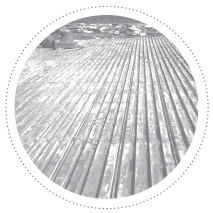
- Securement
Note whether all steel deck panels are securely welded or mechanically fastened to the structural supports. - Welds
Note whether all welds have been painted with a primer to prevent corrosion (if specified). - Panel Laps
Note whether all deck panel laps have been secured in accordance with the structural design. - Cleanliness
Note whether that all flutes are clean, dry and free of ice or snow.
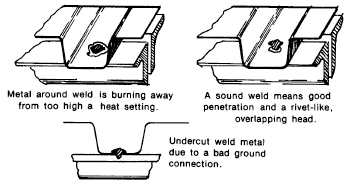
The individual steel decking sheets should, whenever possible, span three or more structural members. All sheets should be of standard lengths and widths.
- The decks should be welded or mechanically attached to the supports through the low ribs in accordance with the structural design, typically at a maximum 300 mm (12 in) o.c., and all the welds should be covered by paint to prevent corrosion.
- The finished welds should resemble a rivet. Side joints must be mechanically fastened in accordance with the structural design.
Roofers should cover the deck with planks or plywood sheets before hoisting any materials and equipment to avoid damaging roof deck. Care should be taken when staging roofing materials on the deck so as not to damage the decking or cause deflection in the deck by placing excessive localized loads on the deck.

Where specified, the steel deck should be covered with a minimum of 12.7 mm (1/2 in) gypsum boards or cementitious boards that are mechanically fastened to act as an auxiliary levelling surface. This gypsum board levelling surface will eliminate a great deal of application problems including:
- Uneven top flanges due to poor deck applications disturbing insulation.
- Asphalt and pitch being used as adhesives for the insulation.
- Cold adhesives with low quality holding power being used to secure insulation.
Gypsum or cement boards are often specified as a thermal barrier to prevent fire from a roof entering into the building. The gypsum board provides a clean, dry surface on which to lay vapour retarder, insulation and roof membrane.
When no levelling layer is to be installed over the steel deck and the insulation is to be installed directly on to the deck. The insulation must be of sufficient thickness to have the flexural strength to span the ribs of the deck. The thickness will vary with the insulation type and the deck type (narrow, intermediate, or wide).
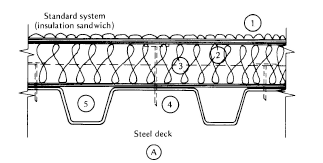
Preformed insulation closure strips should be installed in the deck flutes above and below deck at the perimeter and openings to prevent air leakage and condensation. This is especially useful in preventing the roof from blowing off in high winds during construction. Often, in new construction, parapet walls are completed after the roof has been installed.
Acoustical Decks
Some steel decks have perforated webs (sides) of the ribs. The purpose of the perforations is to dampen noise from activity below the roof. Acoustical decks are often found in arenas, or school gymnasiums. The ribs are usually filled with a compressible insulation prior to the installation of the roof. It is important to take the necessary precautions to prevent asphalt or adhesives from dripping through these openings when the roof is being applied.
3.1.3.4 Inspection of Concrete Decks
There are 3 additional steps for inspecting concrete decks as follows:
- Finish
Note whether the concrete deck has a smooth, trowelled finish and that there are no point projections or rough areas over 1 mm (1/32 in) high. - Joints
On precast decks, note whether panels joints have been grouted. - Level
Note whether precast concrete panels used do not have a height difference of more than 6 mm (1/4 in).
• If there is a greater difference in height, grout should be applied to the top of the higher panel and feathered at a slope of 1:50 over the lower panel.
• If the difference between panels exceeds 19 mm (3/4 in), the deck should be coated with a new layer of concrete in order to achieve a level deck surface.
Cast-In-Place Structural Concrete
High strength concrete is deposited with buckets or pumped to the roof into roof forms. These forms are standard shaped planks supported with plywood and wood forms. Typical form sizes are between 4.5 m x 6 m and 7.6 m x 12.2 m (15 ft x 20 ft and 25 ft x 40 ft).
Some of the advantages of cast in place concrete include:
- Most roof systems can be applied or replaced with little or no damage to the deck.
- Vapour retarders, insulations, and membranes can be adhered directly to the concrete.
- Asphalt can be directly mopped to the dry roof deck (after priming).
- The concrete can be sloped during construction to provide positive drainage.
- It can support large live and dead loads (required for protected membrane roofing systems).
- Concrete is extremely resistant to fire.
- Pipes and false ceilings can be suspended from the underside. Electric conduit can be incorporated right into the slab or attached to the underside.
- Due to the monolithic nature of poured concrete it can act as an effective air barrier.
Precast Structural Concrete Decks
Precast structural concrete decks may be double-tees, single tees or cored slabs supported on precast bearing walls, masonry bearing walls or beam-column framing system. Spans can be 20 m (65 ft) or more and can be 1.5 m to 3 m (5 ft to 10 ft) wide. Tees are typically held together with a welded joint.
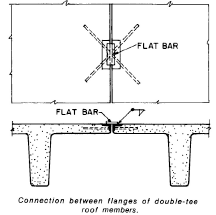
Cored slabs are grouted together with a grout key and tied across a beam with reinforcing bars.
Slopes can be achieved by covering with a lightweight concrete topping or dense concrete.
Panel surfaces should be clean and smooth. The maximum difference in height between panels is 6 mm (1/4 in). When a difference in height between panels of between 6 mm (1/4 in) and 19 mm (3/4 in) exists, the difference should be feathered using acceptable material which can be bonded to the deck. This feathering should also be applied to welded joints and anchor bars. When feathering prevents proper drainage or the difference in height exceeds 19 mm (3/4 in), a topping coat should be applied to level.
Any precast concrete panels provided with grout keys should have the joints filled. A 150 mm (6 in) wide strip of #30 felt should be laid dry over the joint before any materials are mopped to the deck. Panels containing no grout keys should have the joints covered with a 450 mm (18 in) wide strip of #30 felt mopped within 150 mm (6 in) on either side of the joint.
Long-span prestressed concrete decks are difficult to roof over because of thermal movement, jointing and springiness.
Lightweight concrete
These concretes can be grouped as follows:
Lightweight structural concrete – Those concretes made up with aggregates like vermiculite and perlite.
Lightweight insulating concrete – Those concretes made up of aggregates like clay, slate blast furnace ash, or shale or cement mortar and preformed or formed in place foam.
Lightweight concrete needs to be thoroughly understood and handled with care to become a suitable roof deck.
Remember: Document and report all deficiencies in the deck to the project superintendent. Do not proceed with a roofing installation until all deficiencies have been corrected.

